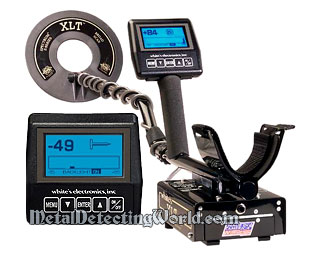White's Spectrum XLT e-Series - a Metal Detector I Successfully Used for 7 Years
My Review and Tips
by Sergei UpstateNY, proficiency level: Beginner, last time modified:
During my third metal detecting season, I upgraded to the next level of metal detecting technology represented by a White's Spectrum XLT.

I successfully used this machine for seven years. Some of my best finds, my first coin cache (see my story - Discovery of a Coin Cache in Upstate New York) and a Bronze Statue "Psyche" by Moreau, ca. 1882, were found with the White's XLT.
Later on, after I switched to Minelab detectors, I often felt nostalgic for the XLT's durability, versatility, light weight, awesome pin-pointing ability, excellent Tone ID and effective performance - key characteristics of an advanced metal detector of the 1990s.
The Spectrum XLT was my first 'tonal' metal detector. While operating the XLT in a 'Tone-ID' mode, I did not have to look at the screen to check target VDI (Visual Display Indication or Visual Discriminate Indication) numbers because I could determine the target's metal content and target's shape by the signal's tone pitch and sound characteristic respectfully. I only looked at the display screen when I needed to see the target's depth reading. Basically the XLT trained me to listen to its audio responses and taught me how to read the target sounds.
When I used a Modulation mode, I did not need to look at the depth indicator because I could determine the target's depth by the signal's amplitude. So the XLT's excellent audio was giving me enough target ID information for making my decision - whether or not to dig up the target. But most of the time I was metal detecting at the sites that did not contain any modern junk, so I dug up every non-ferrous target with a signal sounding "above the iron nail", and did not use the Modulation to make all deep targets sound loud.
The Spectrum XLT can be considered a suitable machine for those detectorists who like experimenting with different combinations of settings - a wide range of them! The XLT's flexibility in adjusting to any soil conditions definitely made this detector a multi-purpose land machine! If it only was equipped with a Double-D search coil back then!
By the time I started using the XLT, I had already had my own Test Garden "growing" - all targets that I "seeded" some time earlier had developed Halo Effects around them. I used my test garden for experimenting with different program settings and developed a few optimal programs for various search conditions. For metal detecting Coin and Jewelry with the White's XLT, I created a basal program (see My Search Program Settings for White's XLT E-Series).
Pacific Ocean Beach in Chile
I had a chance to test my White's XLT detector on the "toughest" red soils - soils saturated with iron oxides, in South America, and the XLT successfully passed all tests.
This machine allowed me to make a variety of remarkable finds during Coin Shooting and Relic Hunting outings in the Andes mountains in Chile, and during Beach Hunting for jewelry and coins on both wet and dry sands of the Pacific Ocean beaches.
One of the XLT's wonderful traits was a noticeable increase in Operating Depth Range - detector's sensitivity to deep targets, when the sweep speed (speed of a search coil's motion) was increased. With fast coil-swinging, not only I could improve audio responses to deep coins during examination of 'questionable' signals, but also cover a relatively vast area in one detecting session. While cache hunting in Upstate New York, I could easily explore or get familiar with one colonial homestead site in one day.
Spectrum XLT and XLT E-Series detectors have been suitable for Meteorite Hunting because of their features such as a S.A.T. (Self-Adjusted Threshold) control and the displayed V.D.I. numbers (Conductivity values of targets). And also, the XLT has been an ideal detector for competition hunts because of its light weight and excellent pinpointing.
Of course, like any metal detector, the White's XLT has some drawbacks. The most inconvenient of them may be the XLT's weakness against moisture. Every time it was raining, I had to cover both the control box and display with zip-lock plastic bags, otherwise the detector would malfunction or stop working completely until its control box's interior was dried out with a hair blower at home.
Another drawback was that the XLT would produce a cacophony of false signals while moving the search coil through the tall wet grass, or when the 'Sensitivity' and/or 'Gain' levels were improperly set for a trashy hunt site. Even taking the battery out without turning the machine off did not help.
The only solution to this problem is to stop detecting, put the detector on the ground in a way that a search coil is placed at a 'clean' spot, and wait a few minutes while keeping the machine turned on. After the microprocessor "rests" a little and does not accumulate any additional incoming data, it resets itself and becomes stable again.
Also, the 'stock' open-center, CONCENTRIC search coil would not detect coins positioned in the dug hole's sidewall or lying close to the edge of the hole. If I had a good solid signal and, after digging the hole, I lost it, I had to take more dirt out of the hole and around it, spread the dirt evenly on the flat surface or a piece of ground cloth (like a regular bandanna), and scan it again to retrieve the detected target. To avoid such a problem while coin shooting around cellar holes containing zillions of targets, I used an 8-inch search coil or a 'sniper' 5-inch coil. Using these coils at trashy hunt sites would always bring better results anyway.
To end this article on a super positive note, I would like to add that the White's XLT may still be a strong rival to its successor - a White's Spectra Vision V³ (and probably all subsequent versions of this model!). Not long ago, I had a chance to use my friend's White's Spectrum XLT while metal detecting next to another friend of mine who used the White's Spectra Vision V3. We were searching a small spot in the field where the 17th century dwelling used to be. This spot had been previously hammered by other detectorists. For this location, I entered my above-mentioned search program into the XLT I was using.
To my surprise, at the end of our hunt, my friend and I had a tie in a number of finds! Not only the numbers of our finds were equal, each of us had a group of identical finds: five copper coins, one silver hammered coin, one pectoral crucifix and a bronze signet ring! I truly expected the White's Spectra V³ to outnumber the XLT in finds, but it did not perform any better than the old good Spectrum XLT. So if you have been successfully using the White's XLT, KEEP IT!
Of course, my opinion is subjective and is based on just one observation. Most likely, before we competed, my friend had not had enough time to learn and master all additional functions incorporated into the Spectra V3, which could give my friend an advantage. But the results of that 'competition hunt' certainly give some 'food for thought' to the XLT users.
One detectorist I know, a real die-hard fan of the White's Spectrum XLT, used it excessively even after the detector started falling apart. But he still would not replace it with anything until he was able to buy a more advanced metal detector.
If you would like to see the White's Spectrum XLT's Features and Specifications and read other users' reviews, please visit the White's Spectrum XLT Review page
